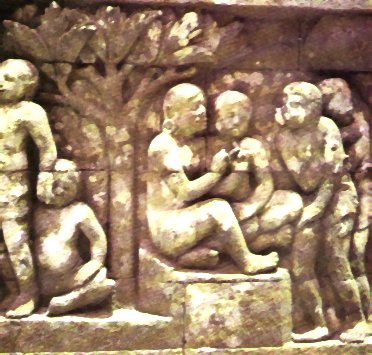
KAMADHATU - Sphere of Desire
Represent by the foot of Candi Borobudur, is accessible at present in four places only. A huge protecting wall of about 12.000 square meters covers most of the reliefs and has preserved them in a largely undamage state. This base accomodated the pictorial reliefs depicting actual life - picture of love, hatred, punishment, happiness, hope and the destitution of hell.

Two theories have developed about the origin of this wall. one is of a constructional nature; As saveral of the 160 hidden reliefs were found unfinished, this theory maintains that, even before the termination of the construction work, the entire monument threatened to collapse and a supporting wall was quickly built around the base of the temple. It was found that the site on which the temple is constructed not only consists of a natural hill but also of filled up earth which. The second theory favours a religious interpretation and presupposes that the massive stone wall had been planned right from the start. The Candi Borobudur was not meant to serve the religious society in general but only a chosen group of monks, who were expected to renounce all human desire in order to reach the sphere of deliverance a,d enligtenment. The theory concludes that on the one hand the sphere of desire had to be depicted, on the other hand, however, it had to be hidden from the eyes of the monks.
The reason why this kind of cover had to consist of a stone wall of these dimensions - 6 m thick and 3 m high - is further explained by the belief that only through "cakrawala", the "Iron Wall", the spiritual world of the Borobudur could exist in its entirety genuinely separated from the rest of the world.
Back to Map of Borobudur Library Contact us
© INSIST 2001